Did you know that nearly 30% of a home’s energy loss occurs through doors and windows? This startling statistic underscores the importance of an effectively adjusted exterior door threshold. In your quest for home energy efficiency, understanding the role of the door threshold and addressing any adjustments can significantly enhance your space. In this guide, you will discover how proper door threshold adjustment not only eliminates drafts and reduces moisture intrusion but also elevates the aesthetic appeal of your entryways. Get ready to empower yourself with the knowledge to tackle this DIY home project with confidence!
Key Takeaways
- Properly adjusted door thresholds improve energy efficiency by minimizing drafts.
- Thresholds play a vital role in protecting against moisture intrusion.
- Adjusting thresholds can enhance the overall look of your entryway.
- Understanding how thresholds interact with flooring can prevent common problems.
- DIY adjustments save money and increase home value.
Understanding Exterior Door Thresholds
When considering the integrity and functionality of your entrance, gaining a clear understanding of exterior door thresholds proves vital. By grasping the threshold definition and appreciating its role, you ensure your home remains secure and energy-efficient.
Definition and Function
Exterior door thresholds form a key element at the base of doors, acting as a barrier between outdoor and indoor spaces. These components come in various materials like metal, wood, and composite options, each designed for durability and effectiveness. The primary threshold function revolves around blocking drafts, moisture, and debris, contributing significantly to your home’s overall comfort.
Importance of Proper Sealing
Effective door sealing around these thresholds is essential for preventing water damage, reducing pest entry, and minimizing energy loss. A well-sealed threshold not only enhances your home’s aesthetic appeal but also extends the life of your doors. Knowing how to maintain proper sealing can save you from costly repairs in the long run.
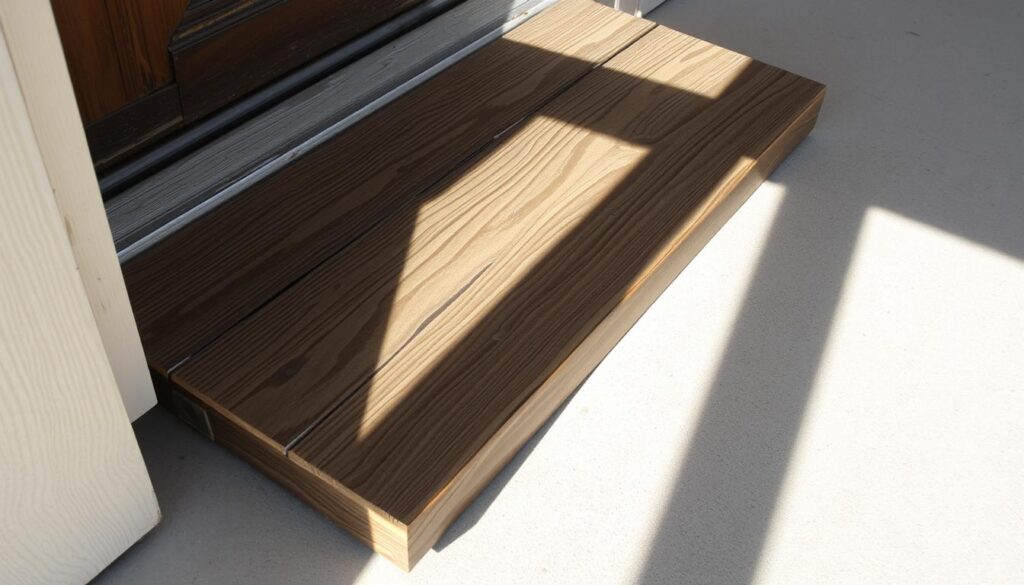
What is a Floating Floor?
A floating floor is a unique type of flooring that is not attached directly to the subfloor. This design allows it to “float” above the subfloor, accommodating natural expansion and contraction caused by temperature and humidity variations. Understanding the characteristics of floating floors offers valuable insights for homeowners looking to enhance their indoor spaces.
Characteristics of Floating Floors
Among the key characteristics of floating floors are their ease of installation and versatility. These floors are typically made with interlocking planks, making DIY installation a feasible option for many. In addition, they provide a cushioned feel underfoot, which enhances comfort while walking. Floating floors are also relatively resistant to moisture, making them suitable for areas like kitchens and bathrooms. Their adaptability to various design styles allows you to choose the finish that best complements your home.
Popular Types of Floating Floors
Several types of floating floors are available to meet diverse aesthetic and practical needs. Laminate flooring stands out for its affordability and wide range of styles, while vinyl flooring offers impressive waterproof properties ideal for high-moisture environments. Engineered wood combines natural wood aesthetics with enhanced stability, making it an excellent choice for those seeking elegance and durability. Each of these types of floating floors provides distinct advantages, ensuring you find an option that fits your lifestyle.
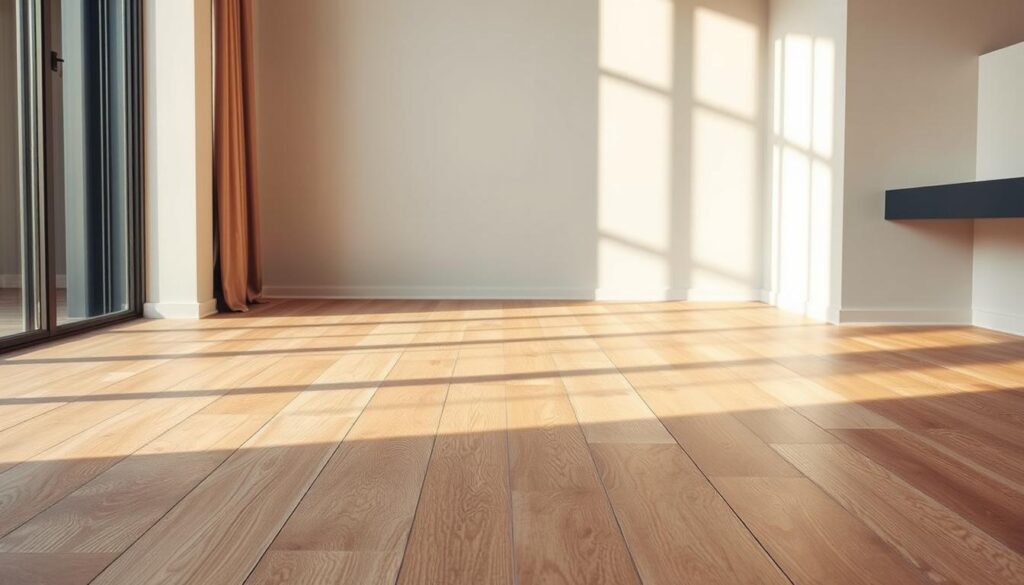
Why Do Floating Floors Require Expansion Space?
Understanding the significance of expansion space in floating floors can help you avoid many common flooring issues. Floating floor expansion is essential because these types of floors undergo changes based on environmental conditions. Variations in temperature and humidity directly affect flooring materials, making it crucial to accommodate their natural expansion and contraction.
Effects of Temperature and Humidity
Temperature effects on flooring can lead to noticeable shifts in the structure. As the temperature rises, materials can expand, affecting how the floor fits together. Conversely, colder temperatures can cause contraction. Similarly, humidity impact on floors cannot be overstated. Excess moisture can cause the material to swell, while dry conditions may lead to shrinkage. Without adequate space for these changes, your beautiful flooring can suffer damage over time.
Common Issues from Inadequate Space
Failure to provide the necessary expansion space can result in a host of problems. You may encounter edge wear, which visually detracts from the floor’s appearance. Cracking may develop along seams, compromising durability and longevity. In addition, moisture accumulation can occur, potentially leading to mold and mildew issues beneath the surface. Planning for floating floor expansion plays a vital role in ensuring a healthy, long-lasting floor.
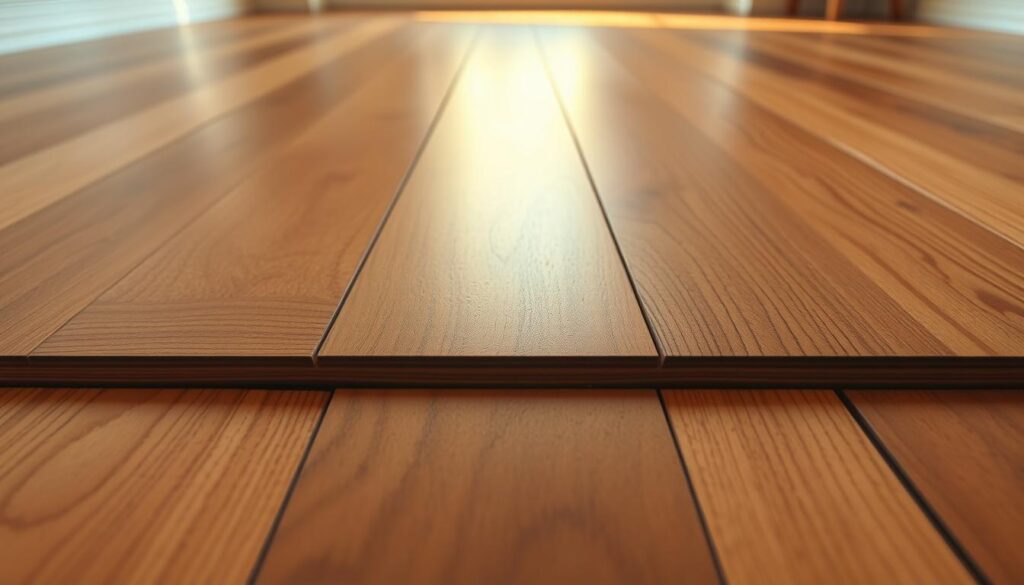
Key Challenges of Floating Floors Meeting Thresholds
When floating floors meet exterior door thresholds, homeowners often face specific challenges. Understanding and addressing these issues is essential for maintaining the integrity and appearance of your flooring. Several aspects require careful consideration, from managing expansion and contraction to tackling moisture concerns at thresholds. Creating a smooth, stable transition is crucial to ensure a seamless flow from indoors to outdoors.
Managing Expansion and Contraction
Floating floors naturally expand and contract due to temperature fluctuations and humidity levels. These challenges with floating floors can lead to buckling or popping, particularly at threshold transitions. Ensuring there is adequate expansion space between the floor and the threshold will help mitigate these problems. It’s essential to use proper installation techniques that factor in these changes over time.
Addressing Moisture Concerns
Another significant issue at thresholds involves moisture concerns. Exposure to outdoor elements can lead to water infiltration, presenting risks such as mold or floor damage. Proper sealing of the threshold and installing a moisture barrier can help protect your flooring from these issues. It’s vital to remain vigilant about any signs of moisture at thresholds to preserve the floor’s integrity.
Creating a Smooth, Stable Transition
To achieve a smooth transition between your floating floors and exterior thresholds, selecting the right transition molding is key. The type of molding you choose can dramatically affect both the aesthetic and functional aspects of your flooring. Ensuring that the molding fits well can prevent gaps, contributing to a polished finish and eliminating potential trip hazards.
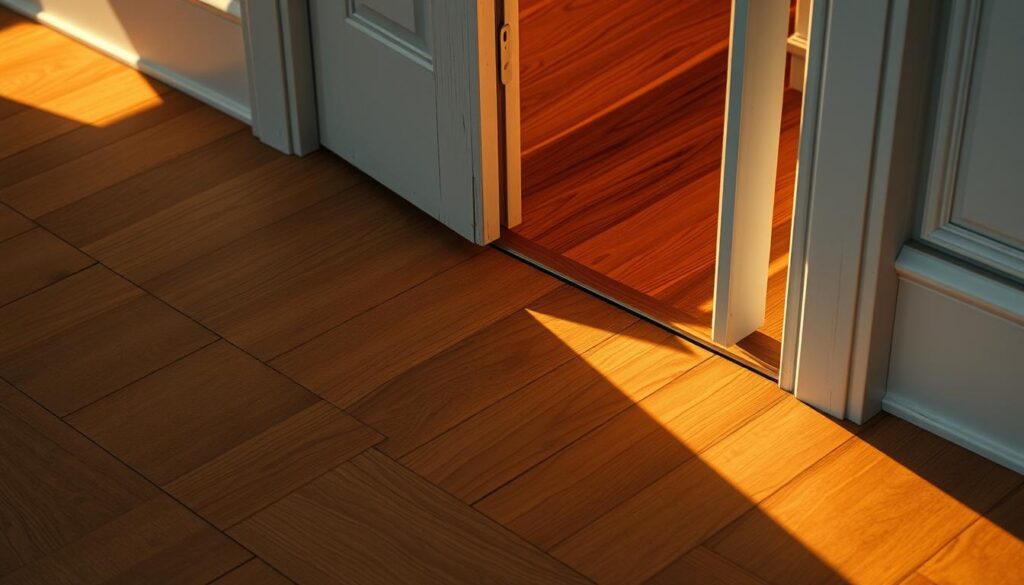
Choosing the Right Transition Molding
Selecting the right transition molding can significantly enhance the appearance and functionality of your floor installation. Transition molding types vary to accommodate different needs, especially where floating floors meet thresholds. Understanding these options will help you make informed decisions for your project.
Types of Transition Moldings
There are several transition molding types, each designed for specific applications. Familiarity with these options can aid in choosing transition molding that complements your flooring style:
- T-Moldings: Ideal for connecting two floors of equal height, suitable for laminate and hardwood.
- Reducer Strips: Excellent for transitions between different heights, like hardwood to carpet.
- End Caps: Perfect for terminating flooring at doorways or edges, offering a neat finish.
- Thresholds: Used where floors meet walls or large fixtures, providing a seamless barrier.
Matching Molding with Floor Material
Floor material matching is crucial when selecting transition moldings. Each type of molding should correspond with the thickness and material of your floating floors to ensure a smooth installation. Here are some tips:
- Assess the height differences between your floors.
- Choose moldings made from the same material as your floor for a cohesive look.
- Consider colors and finishes that complement your flooring style.

Step-by-Step Guide to Adjusting Exterior Door Thresholds
Adjusting door thresholds can significantly improve your home’s energy efficiency and aesthetics. To get started, you will need a few essential tools and materials. This setup ensures you have everything necessary for a successful adjustment.
Gather Necessary Tools and Materials
- Tape measure
- Level
- Transition molding
- Adhesives
- Utility knife
- Wood glue
- Drill
Each of these items plays a crucial role in the process of adjusting door thresholds. Having all your tools for threshold adjustment ready will streamline your efforts and minimize interruptions.
Measuring and Marking the Expansion Gap
When measuring expansion gaps, accuracy is key. Start by measuring the existing gap between the bottom of the door and the threshold. Mark these measurements clearly. You want to maintain consistent widths across the threshold area to ensure it looks polished once the transition molding is installed. Pay attention to the manufacturer’s recommendations regarding specific measurement guidelines for the flooring you’re working with.
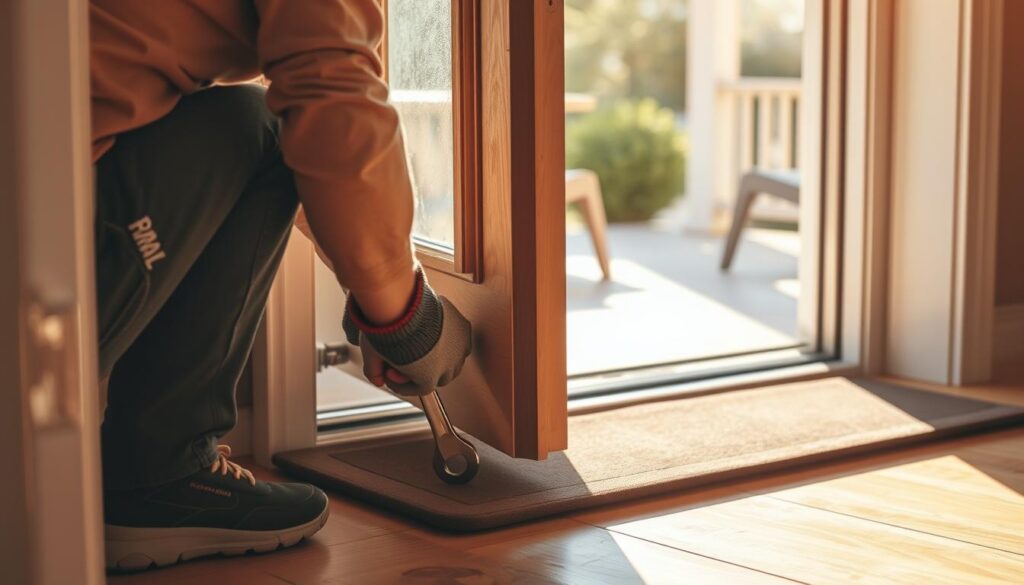
By carefully measuring and marking expansion gaps, you prepare yourself for a smoother installation and a more effective adjustment of your exterior door thresholds.
Installing a Moisture Barrier
Understanding the significance of moisture barriers is crucial, particularly when you are concerned about protecting floating floors. A moisture barrier acts as a safeguard against water damage, especially in regions that are more susceptible to outdoor moisture. Installing one at the threshold is an effective strategy to ensure your floors remain in optimal condition over time.
Importance of Moisture Barriers
The importance of moisture barriers cannot be overstated. They provide a protective layer that prevents water from seeping under your floating floors, thus reducing the risk of warping and mold growth. Proper moisture barrier installation creates a critical line of defense in areas exposed to moisture, such as door thresholds. By integrating a moisture barrier, you drastically improve the longevity and performance of your flooring.
How to Properly Install One
Installing a moisture barrier involves several straightforward steps:
- Prepare the area by cleaning the subfloor thoroughly.
- Roll out the moisture barrier across the threshold area, ensuring it overlaps any underlayment already in place.
- Cut the barrier to fit the exact dimensions, allowing a few extra inches to cover edges.
- Secure the barrier with adhesive or tape, ensuring it lays flat and maintains its position during whichever flooring installation you choose.
By following these steps, you can achieve effective moisture barrier installation that effectively protects your floating floors from potential damage. A well-applied barrier ensures that moisture remains at bay, allowing your flooring to function as designed.

Best Practices for Maintaining Door Thresholds
Maintaining door thresholds is essential for the durability and efficiency of your exterior doors. Regular inspections can help you catch wear and damage early, while DIY threshold repairs enable you to address minor issues before they escalate. Following these practices can significantly extend the life of your thresholds and enhance their functionality.
Regular Inspection and Maintenance
Conducting regular threshold inspections allows you to assess the condition of your door thresholds. Look for signs of wear, such as cracks, separation from the floor, or water damage. Addressing these issues promptly can prevent further deterioration.
- Check for gaps between the threshold and the floor to ensure proper sealing.
- Look for rust or corrosion on metal thresholds.
- Examine wooden thresholds for swelling or warping due to moisture.
DIY Adjustments and Repairs
For minor issues, consider implementing DIY threshold repairs to maintain door thresholds effectively. Simple adjustments can often restore functionality without requiring professional help.
- Realign the threshold if it has become loose or misaligned.
- Fill in small cracks with waterproof sealant to prevent water intrusion.
- Replace worn-out weatherstripping to keep drafts at bay.
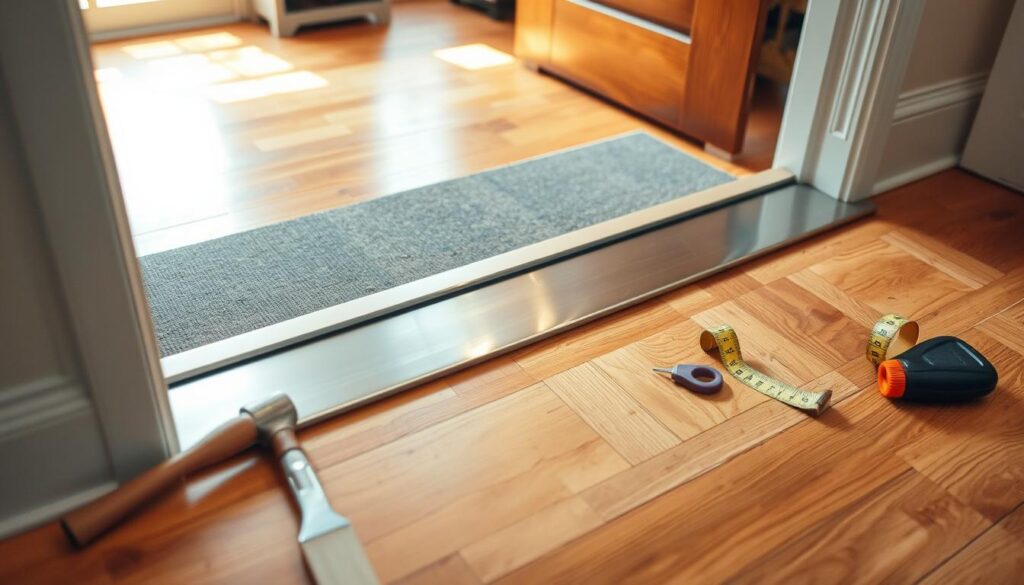
Solutions to Common Issues at Thresholds
When dealing with common threshold issues, you might encounter challenges such as gaps between floors and thresholds or problems like buckling floating floors. These issues can affect not only the appearance of your home but also its comfort and functionality. Understanding how to address these concerns will help you maintain a smooth and secure transition in your space.
Gaps Between Floors and Thresholds
Gaps at thresholds can arise for various reasons, including flooring expansion and contraction or improper installation. For minor gaps, consider using flexible caulk which can fill the space while accommodating slight movements. Should the gap be larger, adjusting the height of the threshold may be necessary to create a seamless transition. Ensuring that materials are suitable and compatible helps in mitigating potential problems down the road.
Dealing with Buckling or Warping
Buckling floating floors are often a result of trapped moisture beneath the surface or inadequate expansion space. Identifying the source of moisture is crucial; it may involve checking for leaks or improving ventilation. Once addressed, allow the floor to acclimate properly before reinstalling. Keeping an eye on humidity levels in your home can help prevent similar issues in the future.
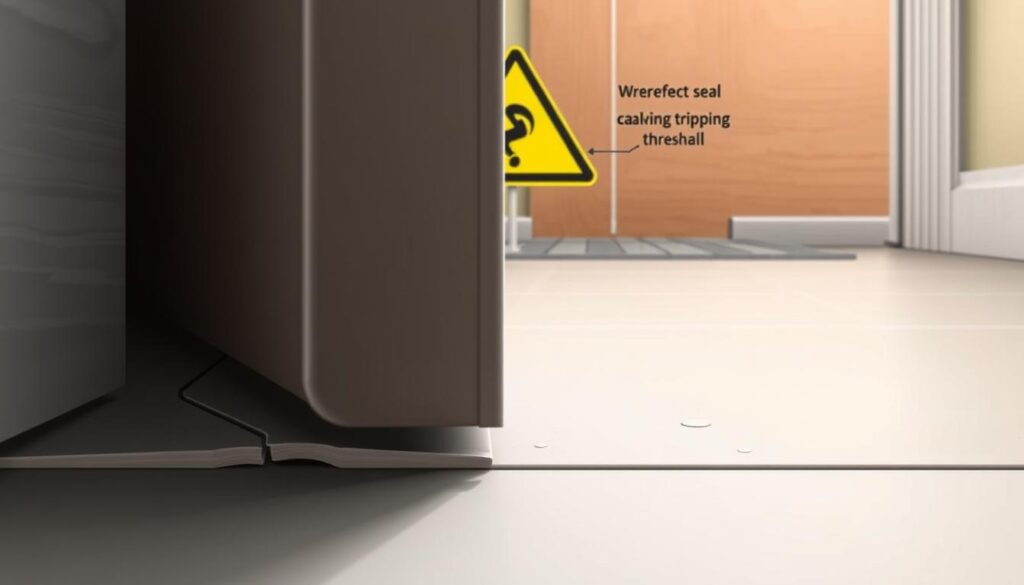
Exterior Door Threshold Adjustment Demystified
Understanding the intricacies of exterior door thresholds can significantly enhance your home’s energy efficiency and functionality. Examining the door frame anatomy reveals essential elements that influence adjustment processes. This knowledge enables you to make informed decisions regarding any modifications required.
Understanding the Anatomy of a Door Frame
The door frame consists of several critical components, including the sill, jambs, and various sealing mechanisms. Each part contributes to how well the threshold performs in preventing water infiltration and air leaks. The sill serves as the base that supports the door and is instrumental in ensuring security and stability. Proper engagement of the jambs allows the door to close snugly, minimizing gaps that could compromise insulation.
Factors Influencing Threshold Adjustment
Several threshold adjustment factors play a crucial role in maintaining the integrity of your door setup. These include:
- Alignment: Proper alignment ensures the door closes effectively against the threshold.
- Weather Conditions: Temperature fluctuations and humidity levels can cause materials to expand or contract, affecting how thresholds sit against the frame.
- Wear and Tear: Over time, regular use can lead to misalignments and may necessitate exterior door threshold modification.
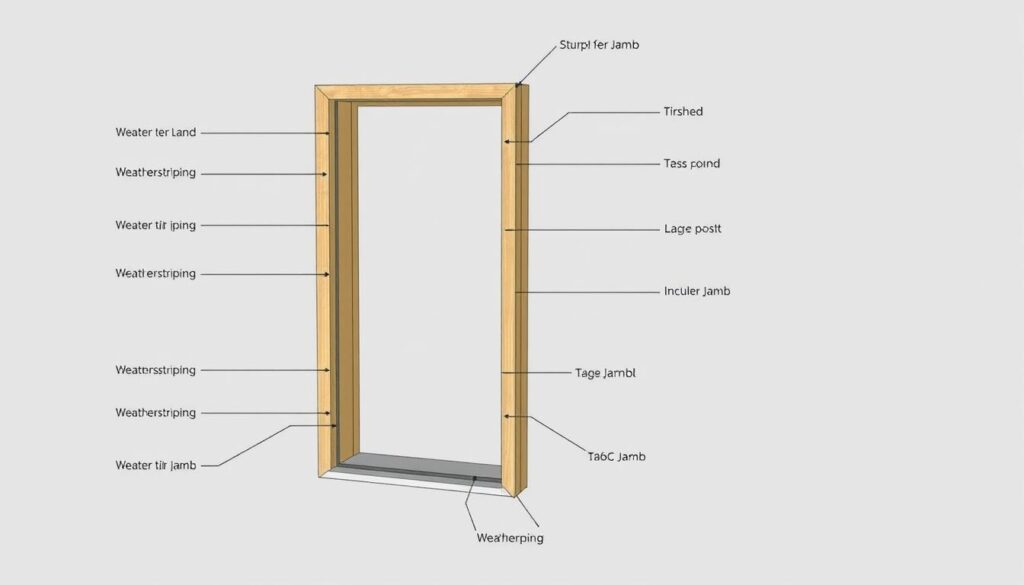
Marking these factors is vital for effective adjustments and maintenance. Understanding these elements can simplify the process and ultimately prolong the life of your doors and thresholds.
Conclusion
In summary, understanding the nuances of door threshold adjustment is essential for maintaining the structural integrity of your home. Proper threshold installation not only enhances your door’s performance but also plays a crucial role in energy efficiency improvement. By sealing gaps effectively, you can reduce drafts and save on heating and cooling costs.
Throughout this article, we’ve explored practical techniques and best practices for adjusting exterior door thresholds. The door threshold adjustment summary highlighted the significance of this often-overlooked aspect of home maintenance. By taking the time to implement these adjustments, you’ll help prevent common issues like moisture damage and floor buckling.
Ultimately, investing in the benefits of proper threshold installation ensures that both your flooring and door thresholds are safeguarded for years to come. Create a smoother, more efficient connection between your indoor and outdoor spaces, and enjoy the comfort and longevity that comes with responsible home care.









